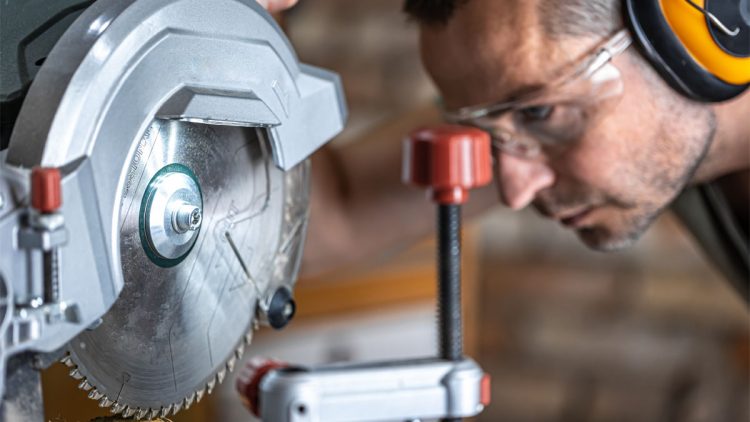What is a Miter Saw?
A miter saw is an ideal tool for precision work, like interior trim. The following is a summary of the pros and cons of this favorable saw.
A miter saw is an essential device in any finishing carpenter’s woodshop, and favorable with DIYers of all levels of skill. If you’ve thought about adding a miter saw to your collection of power tools, but unsure where to begin, keep reading for some background and what to think about when making a purchase on a miter saw.
What Is a Miter Saw?
A miter saw is basically a swivel-assembled circular saw blade that is swayed down into the medium getting cut. Since the swivel is fixed in place, the blade consistently drops down in a controlled movement, producing clean, consistent cuts.
This works perfectly for cutting flat ends; however, a miter saw is also able to rotate right and/or left for cutting at angles. This adaptability makes a miter saw a perfect choice for fine woodworking.
These saws are usually good devices to teach new DIYers concerning working with wood. A protection plate covers the saw blade, and the medium to be cut rests on the miter saw table and is pressed into the saw’s back vertical metal wall.
Novices in woodworking typically find this setup and the basic operation of a miter saw less daunting than the open-air blade of a table saw or bandsaw. Additionally, DIYers that have hand strength problems typically find a miter saw more comfortable to work with than circular saws.
That is not to say to say that a miter saw is not going to pose any danger. Power tools (particularly saws) must always be handled with respect.
Along with power tools, you can most likely carry out the work of a miter saw manually using a miter box and simple hand saw, or by using a different saw. Circular saws can make similar cuts as a miter saw; but it’s a lot more challenging to match the precision and speed.
Types of Miter Saws
Miter saws are categorized by their blade size and the type of cuts they can make, in addition to whether they have a cord or not.
Miter Saw
Every miter saw is able to cut at miter angles, which means that the saw blade can swing left or right. The most basic kind of miter saw is able to cut a miter to the right and (typically) to the left.
Compound Miter Saw
A compound miter saw not just swivels left or right but additionally tilts at an angle for creating beveled cuts. Many compound miter saws enable a tilt in both directions, whereas some restrict the bevel to one side. Those that enables bevels in each direction are often referred to as “dual bevel” or “dual compound.”
Sliding Miter Saw
One of the primary restrictions of a miter saw is how wide it can cut. A sliding miter saw utilizes rails enabling the blade to glide a short distance as it cuts, adding valuable inches to the cutting width. A lot of smaller-blade miter saws have the addition of rails to enable the lighter, more mobile body for making cuts on wider trims.
Compound Sliding Miter Saws
Sure enough, compound sliding miter saws feature beveled cuts and sliding rails. These are typically the most costly and heaviest among miter saws, but they are additionally the most adaptable.
Blade Sizes
Miter saws have a fixed size, represented by the diameter of the saw blade they are able to accept. Meaning that a ten-inch miter saw has a blade ten inches in diameter.
The most typical miter saw sizes are ten-inch and twelve-inch. Most ten-inch miter saws are able to cut up to a 6-inch board at ninety degrees and a 4-inch board at forty-five degrees. A twelve-inch miter saw is able to cut an 8-inch board at ninety and a 6-inch board at forty-five degrees. (Take note that the above sizes are dimensional wood measurements, so the true cutting size is going to be somewhat smaller.)
Other favorable sizes include seven and one quarter and fourteen inches for people that work with slim trim or larger materials, correspondingly. A lot of DIYers choose a ten-inch saw since it provides a great balance of cost, mobility and cutting adaptability.
Corded or Cordless
Historically, miter saws have cords; however, improved cordless advancements means you can use a miter saw devoid of any cord. There are a minute number of gas-powered miter saws, but those won’t be covered here.
Pros and Cons of Miter Saws
The following are the pros and cons of Miter Saws
Pros of Miter Saws
Precise crosscuts: Miter saws enable the angle to be locked in and typically have stops fixed at common angles.
Quick, readily repeatable cuts: After a miter saw is set up, it can make repeated, corresponding cuts.
Less daunting for newer users: The steadiness and protected blade, make it a great introduction saw for untrained DIYers.
More accessible for individuals with restricted mobility: Miter saws enable accurate crosscuts without requiring controlling the weight of a circular saw or to spread across a table saw.
Miter saws are an ideal choice for accurate work like wooden frame-making or interior trim. A miter saw’s controlled motions and range of travel also make it easier for DIYers with restricted hand strength.
Cons of Miter Saws
Restrictions on material width: You are going to require a different tool for cutting wider materials.
Heavy and cumbersome: Even though the actual cutting process requires minimal force, miter saws are much more heavier to move around a workshop than circular saws.
Takes up floor space: Miter tables are not broad enough for supporting longer boards. So, you are going to have to set up temporary support on each side or construct a permanent sawing station, which takes up invaluable floor space in a not quite so big shop.
Miter saws are not for your shop if you mainly rip long pieces of lumber or crosscut wider materials. They provide an excellent workstation but are nowhere nearly as portable as circular saws. A lot of DIYers that own miter saws also invest in a table saw for cutting wood to length.
Woodworking Supplies Mesa by Timber Woodworking
Timber Woodworking offers hardwoods in Mesa, Arizona. We specialize in woodworking tools, equipment, and supplies for commercial woodworking cabinet shops or furniture manufacturers as well as the home shop hobbyist. Contact us today, or call if you should have any questions.

